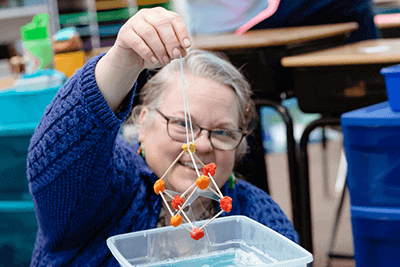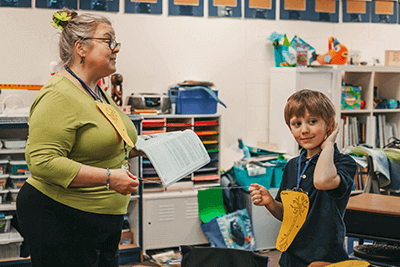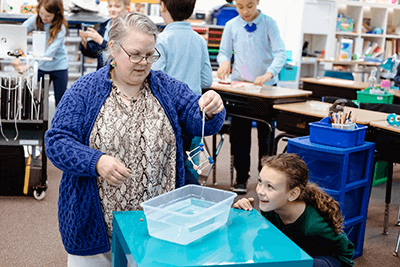September 22, 2025
 The start of the school year brings fresh routines, expectations, and environments for students of all ages. At Mounds Park Academy, teachers take thoughtful, research-based steps to help learners acclimate and thrive—both as individuals and as a community.
The start of the school year brings fresh routines, expectations, and environments for students of all ages. At Mounds Park Academy, teachers take thoughtful, research-based steps to help learners acclimate and thrive—both as individuals and as a community.
We connected with Ms. Tami Fisher, second-grade teacher, about the intentional routines, language, and classroom structures she uses to create a joyful, respectful, and engaged learning environment in these first critical weeks. The benefit of these intentional routines is that they support both students and the classroom community, fostering responsibility and a positive atmosphere.
How do you set the tone at the beginning of the year so that students know what classroom routines and habits are expected while also being engaged learners?
We use the guiding principles and practices of “Responsive Classroom,” a research- and evidence- based teaching approach. Creating community and incorporating student voices are key. In the first weeks of school, we are doing a lot of “looks like, sounds like, feels like” Y-charts. In terms of the classroom routines and expectations, I like to start with the ‘feels like’ aspect, as that helps us identify what we want and need to see and hear in order to make sure our spaces feel the way we want. We look at routines and materials with intention, never assuming we all know how to use them. We use guided discoveries and modeling as we review available classroom tools: what do we notice about them, how can we use them, how they help us learn, and how we care for them.
We all want to be seen, heard, and valued. One of the most important ways we do that is to begin and end our day in community. We do this with a morning meeting and a closing circle. We start the morning meeting with a mindful moment and a greeting to our classmates. This shared time allows us to make connections with one another, and the whole activity provides an opportunity for teamwork while also setting us up for academic application. Lastly, we engage in some brain gym warm-ups that help our brains and bodies get ready for the day. Well-established routines help students spend more time engaged in meaningful learning rather than managing confusion or behavior.
Hopes and Dreams, an integral part of the Responsive Classroom approach, are also used to develop community and student voice. Each member of our classroom identifies their hope and dream for the year while also considering what we want our classroom to look, sound, and feel like. Students collaborate on this initiative and will agree on how we interact with one another in order to be safe, be kind, and do right.
Teacher language is also important! Reinforcing when we notice strengths, positive behaviors, and accomplishments; proactively helping students remember expectations before beginning a task or routine; redirecting by always using a calm voice; and consistently giving clear directions when students get off track are all so important.
Once we’ve established our expectations, it’s about learning how to put them into practice. We rely on modeling. Teachers implement and model routines for students, demonstrating each procedure step-by-step. When we notice one person doing the correct thing, we acknowledge and celebrate it, but also note that it is something we can all do. Sometimes, this means going back and doing it again if we haven’t quite met the expectations. I try to incorporate games or activities that allow us to practice the skills in a fun and joyful way!
By establishing these routines, rules, and procedures in the first weeks of school, we create successful learning environments that foster a positive community where all students feel supported and engaged.
 If a student struggles with listening or processing instructions, how do you support them so that they can grow in that area?
If a student struggles with listening or processing instructions, how do you support them so that they can grow in that area?
This is where the classroom agreements and expectations come into play. When a student is struggling with what I call “making CHAMP choices,” we notice and name the behavior that either happened or they are currently struggling with—a reference to our Lower School character education program, CHAMP (Character Happens at Mounds Park). We then brainstorm and identify some strategies that would help the student meet the expectations of the classroom.
In an academic sense, I use both visuals and words to present our daily tasks and schedule. We have daily slides that go through what we need to accomplish, while displaying the schedule for the day. Our goals for the day will be on them as well. I separate these categories into “condiment” visuals:
- Mustard is the “must-do” for the day;
- Ketchup is the “catch-up” and complete unfinished work; and
- Mayo is the “may-do” choice once the mustard and ketchup tasks are complete.
I also use Total Physical Responses (TPRs) to engage students, which gives me a quick idea of whether they are understanding a concept or struggling to still grasp the lesson. I always ask, “What questions do you have?” and offer a chance to give clarifying information. If a student realizes they do not understand, or are stuck on something, once question time has passed, they utilize the “now serving board.” This is a board in front of the class, where they write their desk number on the board. As I move through the classroom helping, I will start with those who have put their number on the “now serving board.” This helps develop students’ self-advocacy and executive function skills as well.
Finally, we always try to focus on a growth mindset by using language that gives power to “not yet” instead of “I can’t.” Maybe a student doesn’t understand “yet,” but they will!
How do you encourage curiosity and creativity so that children feel eager to discover the joy of learning?
So many ways! But one that comes to mind is using thinking and questioning routines from the “Visible Thinking” framework developed by Harvard Project Zero. One of my favorites is “See-Think-Wonder.” When a picture, object, or even concept is introduced, I ask, “What do you see?” either in the picture or in the concept being studied. Then, after sharing answers, I move to the question, “What makes you say that?” This digs into more specific details. Finally, I encourage them to combine their thoughts from “see” and “think” to infer, “What do you think is happening or will occur?”
Exploring different topics allows students to develop a joy for learning, as they discover what excites them and motivates them to dig deeper.
Our classroom has a “Wonder Wall” where students can leave a question on any topic. I will answer these questions and incorporate them into our learning. As much as possible, I want student interest to guide how we approach learning each day.
 What do you do to help every child feel successful so that they build the confidence that fuels this joy of learning?
What do you do to help every child feel successful so that they build the confidence that fuels this joy of learning?
We honor, support, and meet everyone where they are in their specific journey. I really want to instill that mistakes are proof that we are trying. They prove that our brains are growing and help prepare students for the future. It is also so important to recognize all achievements, both big and small, and provide opportunities for each student to shine.
Reflecting on the start of the school year, what is one early practice that makes the biggest difference in creating a positive, respectful, and engaging classroom community?
My favorite routine, which we start on the very first day of school, is closing with a joke of the day. In our closing circle, we share the joke, and no matter what kind of day we have all had, it ends with smiles and laughter. After we share the joke and laugh, we close out the day with a team clap. This leaves us with a ring of teamwork and community before we leave our space for the day.
At Mounds Park Academy, teachers like Ms. Fisher understand that meaningful learning begins with belonging. By combining clear routines, consistent expectations, and joyful engagement, she creates a classroom culture where students feel safe, curious, and empowered to grow. Whether it’s through a morning meeting, a growth-mindset mantra, or a joke that sends them home smiling, her work underscores the idea that children thrive when they are known, supported, and challenged. The habits and language she introduces in these early weeks are more than classroom management—they’re the foundation for lifelong learning, empathy, and confidence. In every detail, Ms. Fisher helps students see themselves not just as learners, but as valued members of a vibrant and respectful community.